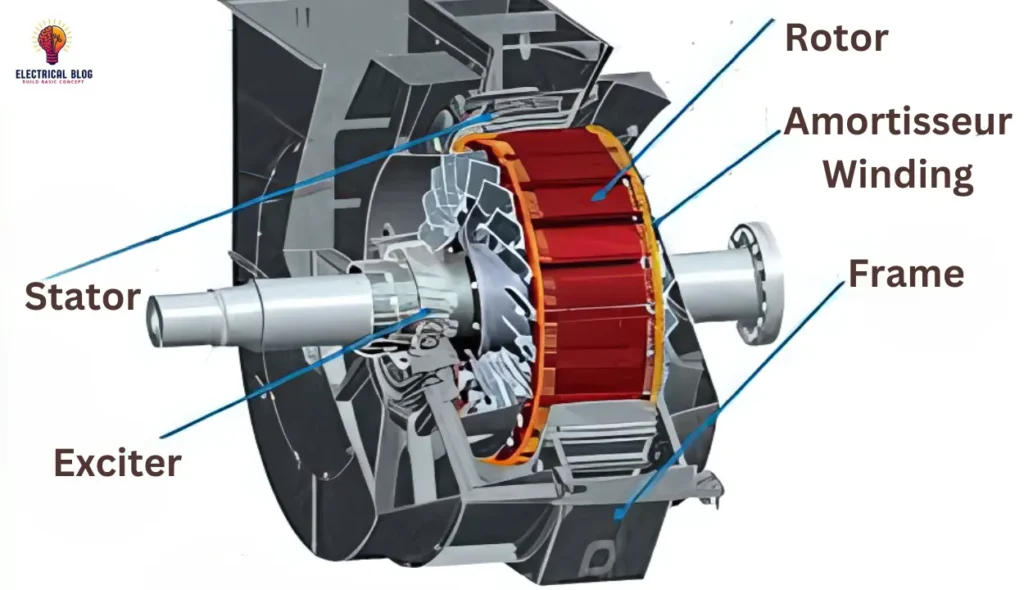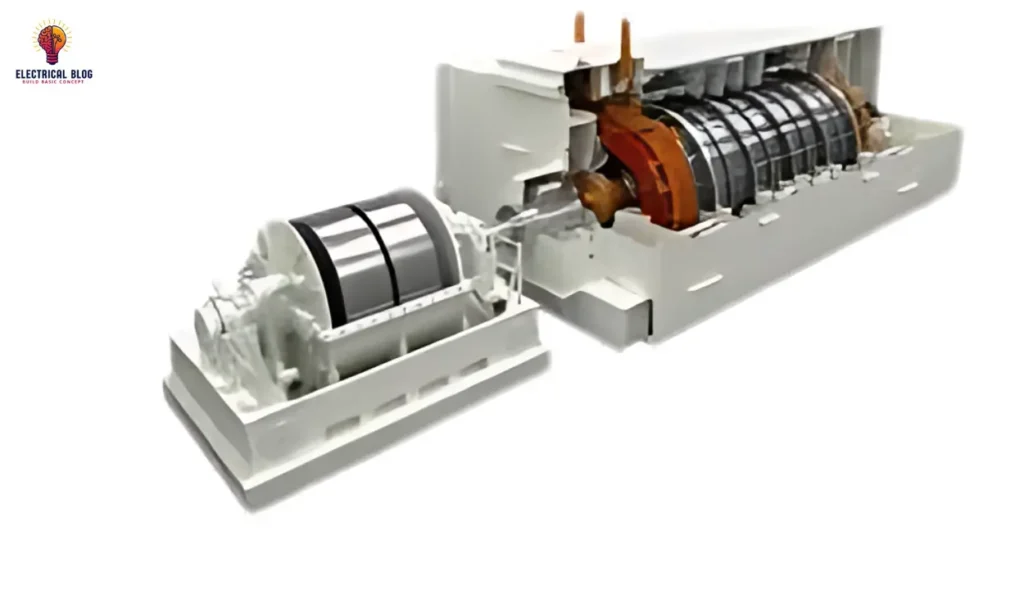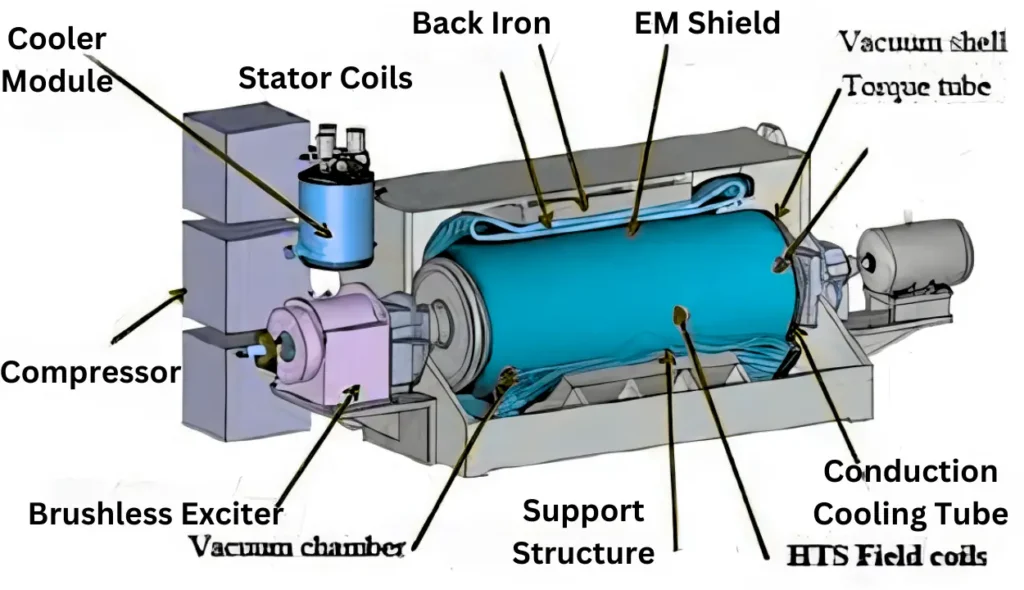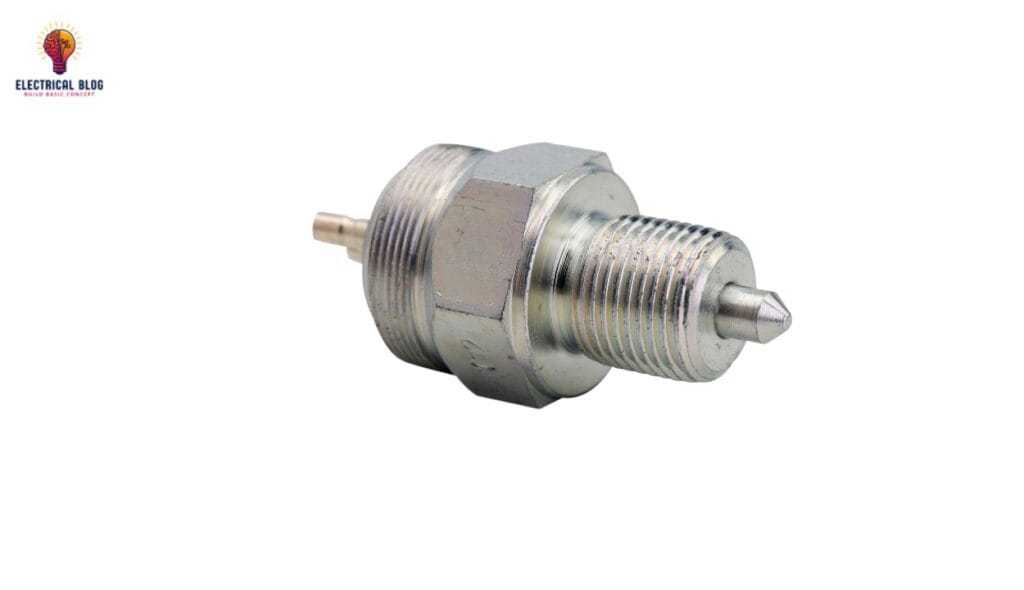Introduction
A synchronous condenser is a powerful device used to enhance the stability of electrical systems. Since the 1950s, these machines have played a helpful role in improving frequency control and stabilizing the network during changes in demand.
By using kinetic energy stored in its inertia, a synchronous condenser can absorb or generate reactive power. This feature strengthens the whole power grid, especially during large load fluctuations, making it helpful for various applications.
What is a synchronous condenser?
A synchronous condenser is a rotating machine that improves voltage and frequency regulation in electric networks. It acts as a compensator, absorbing or generating reactive power to maintain stability. Unlike capacitor banks or electronic devices, it provides improved performance by offering mechanical inertia to the system. This makes it highly effective in controlling short-circuit conditions and reducing risk during islanding events. Its DC-excited design allows it to adjust its output as needed.
The synchronous condenser has a shaft that turns continuously, similar to generators, but without driving a load. It is a reliable solution for enhancing transmission lines in areas with high renewable penetration. With its strong capabilities, it can convert DC-excited energy into rotational force, strengthening the network. This alternative method has become the main choice for improving long-distance power flow, offering stable control for complex equipment and grid operations. You can also read power factor improvement methods.
Synchronous condenser diagram

Technology Types
Synchronous condensers are available in various types designed to regulate voltage and improve stability in distribution systems. Conventional types use electromagnets and excitation to maintain stable power flow during changing grid conditions. Modern designs with HTS (High-Temperature Superconductor) materials offer higher efficiency and less power loss. These systems are driven by a motor or AC supply for continuous operation. For contingency situations, they provide automatic support to compensate for reactive demand.
Advanced development in electronics has made synchronous condensers more economically viable and technically effective. Some models have lighter ratings yet deliver the desired kVAr output under less demanding conditions. Special cooling methods further improve efficiency and extend equipment life. Their exciter units are often simpler and operate with less complexity than before. This makes them ideal for improving transmission lines and ensuring a steady power supply in various applications. You can also read Power Triangle.
Synchronous Condenser Design
A synchronous condenser is carefully designed with key components that ensure efficient performance. The rotor is mounted on a shaft and includes windings to create a magnetic field. A DC exciter supplies current to the field winding for stable operation. The stator uses a 3-phase connection to handle external current flow.
The machine includes an amortisseur winding that helps with starting and reduces slip. Its poles are set in north-south pairs to align with the magnetic flux. The frame holds the iron core, improving torque stability. This direct current setup ensures precise step control, preventing lock issues in induction-based systems.
Working of Synchronous Condenser
A synchronous condenser operates by creating a magnetic flux through its field winding. A DC excitation supply powers the revolving field to generate the required EMF. The armature in the stator receives 3-phase current from an external source. This operation maintains a stable PF (Power Factor) by controlling reactive power.
The synchronous condenser can switch modes to meet grid requirements. In normal-excited mode, it runs at a unity power factor, ensuring efficient operation. In under-excited mode, it absorbs excess reactive power, stabilizing low voltage issues. Meanwhile, in leading or over-excited mode, it generates reactive power to increase voltage levels.
An interlocking system controls excitation to ensure smooth changing of modes. This design helps offset motional disturbances and keeps speed steady. The conductor structure and controlled winding balance increase or reduce power needs. As a result, the system operates with less risk, improving grid stability and ensuring reliable power flow.
Phasor Diagram of Synchronous Condenser
A phasor diagram helps explain how a synchronous condenser controls power flow. When over-excited, the device behaves like a capacitor, supplying leading current for PF improvement. The angle between V and Eb shifts towards 0 or 90 degrees, depending on the load condition.
In a typical characteristic, a small angle indicates minimal phase shift, while an advanced angle shows an increase in leading current. This property makes the motor-like condenser extremely useful for balancing voltage under dynamic conditions. The diagram clearly shows these shifts and their impact on system stability.

Advantages and Disadvantages of Synchronous Condensers
Advantages:
Provides increased system stability by improving voltage control.
Helps boost reactive power to manage grid demand.
Offers strong inertia, ensuring better ride-through capability during faults.
Delivers stepless adjustment for precise power-factor correction.
Improves short-term overload response for better system security.
Enhances system strength by adding mechanical torque to the grid.
Requires no additional auxiliary equipment for voltage control.
Effectively reduces harmonics in the system, ensuring smoother performance.
It can handle huge power fluctuations due to its flexible windings.
Provides a quick response in attaining stable voltage levels.
Helps stabilize short-circuit conditions by adjusting field excitation.
Ensures a maintenance-free operation with minimal cooling needs.
Extends the lifetime of other power equipment by balancing the power flow.
Disadvantages:
More expensive compared to other power correction devices.
Occupies a larger space due to its motor-based structure.
Requires careful checking and maintenance of the setup to ensure proper performance.
Cannot provide continuous voltage support without an increased energy source.
Needs additional thermal protection to prevent system overload.
Involves increased energy losses in low-demand conditions.
Not self-starting, requiring external energy for initial activation.
Applications of Synchronous Condensers
Synchronous condensers help electric power systems by boosting voltage stability. They are useful when grid conditions change.
They are preferred for controlling inductive behavior in HVDC and long transmission lines.
Commonly utilized in solar and wind energy plants to manage load fluctuations and PF (Power Factor) correction.
Provide support during contingency situations, ensuring balanced voltage levels.
Useful in hybrid power systems, enhancing distribution regulation for improved performance.
Connect capacitor banks to maintain a stable voltage ratio and lower resistance losses.
Synchronous Condenser Vs Capacitor Bank
| Aspect | Synchronous Condenser | Capacitor Bank |
|---|---|---|
| Function | Acts as a compensator to manage reactive power and stabilize voltage. | Provides static power correction by connecting in parallel to the grid. |
| Performance | Offers continuous adjustment, improving low voltage issues in transmission lines. | Operates in fixed combinations, providing less control over changing demands. |
| Cost and Efficiency | More expensive but offers higher efficiency and longer lifetime with stable performance. | More economical but has a decreased life in demanding conditions. |
| Flexibility | Uses a DC-excited motor for flexible power control, which can be easily adjusted as grid needs change. | Uses capacitors with limited adaptability and less effective under dynamic system changes. |
| Application | Commonly installed in substations and series connections for improved power flow. | Often used in simpler power correction setups with parallel installations. |
Conclusion
A synchronous condenser helps improve voltage stability, control reactive power, and keep the grid stable during changes. Its ability to adjust power smoothly, improve power factor correction, and handle short-term overloads makes it a favorite in transmission and distribution networks. It may be costly and need extra space, but it plays a key role in controlling inductive behavior. It also supports renewable energy systems and helps maintain voltage levels. This shows its importance in today’s power systems.



